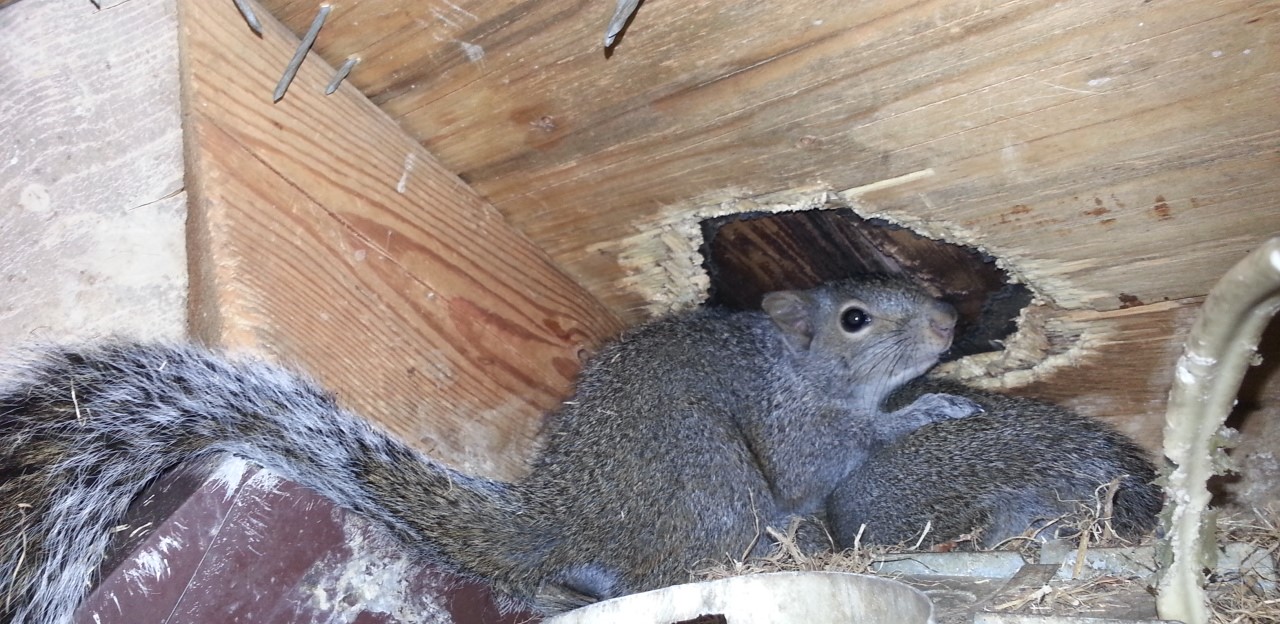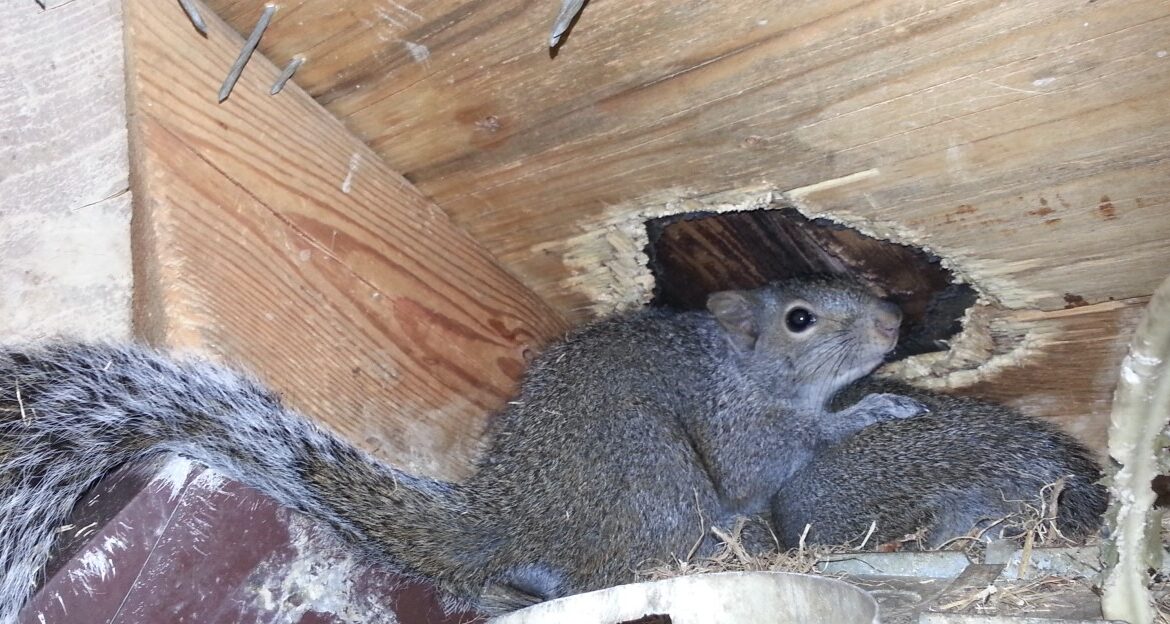Squirrels may seem like fluffy, carefree acrobats in your backyard, but when the winter chill sets in, how do they really cope with the cold? These nimble creatures are more resilient to freezing temperatures than we might think.
Unlike humans who bundle up in layers of coats and scarves, squirrels have their own clever methods to stay warm. They use their bushy tails to stay warm, find snug dens for shelter, and store food to keep their energy up during the winter.
But do squirrels feel the winter cold like humans do? It turns out not quite the same. While they do experience cold, squirrels are naturally equipped to handle it much better than us. However, their efforts to survive the cold can lead them into cozy attic spaces or warm corners of your home, causing squirrel damage to your house.
If you’re dealing with this issue, you might be considering how to get rid of squirrels effectively and humanely. At Skedaddle Humane Wildlife Control, we specialize in squirrel removal in Coquitlam. Both your home and squirrels are treated with care. Throughout this blog, we’ll dive into how these fascinating animals endure the frost and what you can do to prevent any unwanted winter guests in your home.
How Squirrels Prepare for Winter
While we stock up on comforters and hot cocoa, squirrels busily prepare for winter in their own energetic ways. Their secret weapon is successfully gathering and storing food before the cold fully arrives.
First, let’s talk about food storage. Squirrels are known for their skillful hoarding, and they work tirelessly in autumn to set aside enough food to last through winter. They bury seeds and nuts all over the place, ensuring they have a reliable food source when the ground is frozen and vegetation is limited. This practice helps them avoid constant foraging in bitter temperatures.
Another major adaptation is their body changes. Squirrels grow thicker fur to help keep them warm during the cold weather. They also put on additional body fat in their foraging frenzy during fall. This extra fat gives squirrels energy, helping them stay warm and survive on days when it’s too risky to go outside.
Behavioural Adaptations to the Cold
Squirrels have developed clever strategies to stay warm when temperatures drop. These antics ensure they remain cozy even in harsh weather conditions and minimize any discomfort from the cold. Let’s explore how they manage to keep warm with various adaptations.
- Nest Building: Squirrels build insulated nests, known as dreys, high up in trees using twigs, leaves, and other natural materials. These structures serve as safe havens, providing protection from the biting winter chill. Sometimes, if dreys are unavailable, they may go to your attic or other parts of the house.
- Huddling Together: Another way squirrels battle the cold is by huddling together. By gathering in groups, they share body heat, creating a communal source of warmth that helps conserve energy during frigid periods.
- Lowering Activity: During the coldest days, squirrels reduce their activity levels significantly. By staying still and limiting their movements, they conserve vital energy, which is critical when food is scarce and the temperature plummets.
- Thickened Fur Coats: As the cold season approaches, their fur becomes thicker and denser, offering an extra layer of protection against harsh temperatures. This natural insulation keeps them considerably warmer.
- Fat Storage: Finally, the fat they accumulate during the fall acts as a reserve when food is not readily available. This stored energy is burned slowly, ensuring they remain nourished even without constant foraging.
Learning about these survival tactics shows how tough squirrels are and helps us appreciate their role in nature. While they find ways to stay warm, it’s also important to take steps to keep them from entering our homes during the winter.
Do Squirrels Feel Cold the Same Way Humans Do?
Given these nifty adaptations, it seems like squirrels might laugh in the face of winter, but do they feel cold the same way humans do? The short answer is both yes and no. Unlike us, squirrels possess a different physiology that equips them for colder temps. Here are a few things to keep in mind.
- Fur Insulation: Their thick and dense fur coats act as a natural barrier, trapping heat close to the body and shielding them from harsh conditions. It’s like wearing a permanent winter coat that they don’t need to take off.
- Higher Metabolism: Squirrels have a rapid metabolism, which helps produce body heat. This high metabolic rate ensures they can remain warm even when temperatures drop.
- Efficient Heat Regulation: The squirrel’s body is adept at regulating internal temperatures, conserving heat when it is cold outside. This efficiency minimizes energy loss and keeps them cozy.
- Accessing Nutritional Reserves: By storing fat during the warmer months, they have a consistent energy supply. This fat acts as an internal fuel resource, providing warmth even if external food sources become limited.
- Strategic Shelter Building: They skillfully construct well-insulated nests that provide protection and warmth. These structures are carefully chosen or built in locations that maximize warmth and shelter from wind and snow.
The Role of Shelter in Winter Survival
Squirrels are experts at seeking out warm places to wait out the cold. They find creative spots in nature and, sometimes, in human-made structures to stay safe and cozy during winter.
In the wild, squirrels often find cozy tree cavities or build nests high up in trees out of leaves, twigs, and other materials. These nests, called dreys, are insulated to keep them warm when the temperature drops. Some squirrels also dig burrows in the ground, which act as natural hideaways from harsh weather, providing a snug spot to ride out chilly days. These strategies help keep them protected and sheltered from the elements.
However, when natural options aren’t available, squirrels can sometimes move into human spaces. Attics, sheds, and other parts of a house may offer the warmth and protection they seek during winter. If they get inside, it’s important to know how to deal with them properly to prevent any damage.
Squirrels are smart animals who can adapt well to their surroundings, which helps them survive even the coldest months. By learning where squirrels find shelter, we can live alongside them peacefully, keeping them safe while protecting our homes from any issues.
How Skedaddle Can Help with Squirrel Removal
Squirrels have amazing ways to survive winter. They gather food, build nests, and even huddle together to stay warm. But when it gets really cold, they need plenty of food and solid shelter to make it through. Just like us, they need a plan to escape the freezing weather.
If squirrels have picked your home as their winter shelter, don’t worry. It’s important to call in professionals to protect your house from squirrel damage. Skedaddle Humane Wildlife Control in Coquitlam offers safe and humane squirrel removal services.
We’ll help make sure the squirrels return to nature while keeping your home safe and secure. Reach out to us for a solution that respects both your property’s integrity and these creatures’ well-being.
For further information or a quote on how to get rid of squirrels, give Skedaddle a call. Discover how we can make winter safer for homeowners and our furry neighbours.




